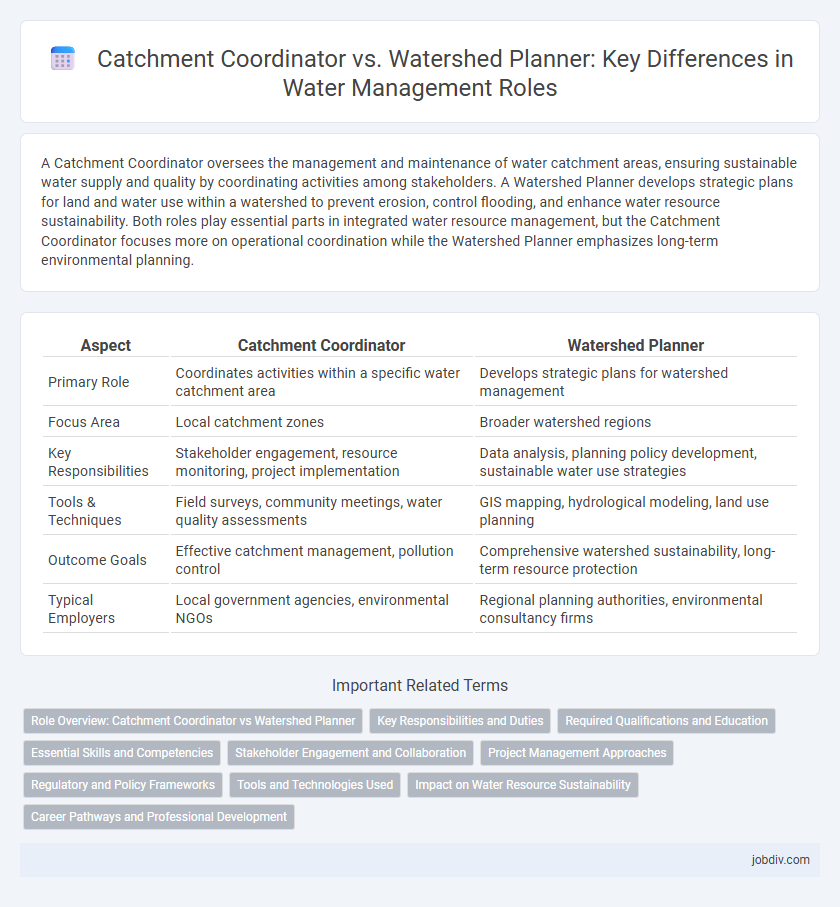A Catchment Coordinator oversees the management and maintenance of water catchment areas, ensuring sustainable water supply and quality by coordinating activities among stakeholders. A Watershed Planner develops strategic plans for land and water use within a watershed to prevent erosion, control flooding, and enhance water resource sustainability. Both roles play essential parts in integrated water resource management, but the Catchment Coordinator focuses more on operational coordination while the Watershed Planner emphasizes long-term environmental planning.
Table of Comparison
| Aspect | Catchment Coordinator | Watershed Planner |
|---|---|---|
| Primary Role | Coordinates activities within a specific water catchment area | Develops strategic plans for watershed management |
| Focus Area | Local catchment zones | Broader watershed regions |
| Key Responsibilities | Stakeholder engagement, resource monitoring, project implementation | Data analysis, planning policy development, sustainable water use strategies |
| Tools & Techniques | Field surveys, community meetings, water quality assessments | GIS mapping, hydrological modeling, land use planning |
| Outcome Goals | Effective catchment management, pollution control | Comprehensive watershed sustainability, long-term resource protection |
| Typical Employers | Local government agencies, environmental NGOs | Regional planning authorities, environmental consultancy firms |
Role Overview: Catchment Coordinator vs Watershed Planner
A Catchment Coordinator manages on-the-ground water quality improvement projects and coordinates community engagement within a specific catchment area, ensuring compliance with environmental regulations. A Watershed Planner develops strategic management plans for entire watersheds, integrating land use, water resources, and ecological data to support sustainable water management. Both roles are critical for protecting water resources but serve complementary functions: operational project coordination versus strategic planning.
Key Responsibilities and Duties
Catchment Coordinators oversee the management and restoration of water catchment areas, ensuring sustainable water quality and supply by coordinating community engagement, monitoring environmental impact, and implementing conservation practices. Watershed Planners develop strategic plans for watershed management, analyzing hydrological data, assessing land use impacts, and designing policies to mitigate flooding, erosion, and pollution. Both roles require collaboration with stakeholders but differ as Catchment Coordinators focus on operational execution while Watershed Planners emphasize long-term planning and regulatory compliance.
Required Qualifications and Education
Catchment Coordinators typically require a bachelor's degree in environmental science, hydrology, or natural resource management, along with experience in community engagement and project coordination. Watershed Planners often hold advanced degrees in water resources management, environmental planning, or civil engineering, emphasizing skills in GIS mapping, hydrologic modeling, and regulatory compliance. Both roles benefit from certifications in environmental planning or water resource management to enhance technical expertise and professional credibility.
Essential Skills and Competencies
Catchment Coordinators require strong skills in hydrological data analysis, stakeholder engagement, and project management to effectively oversee water resource initiatives in catchment areas. Watershed Planners must excel in spatial analysis, environmental impact assessment, and policy development to design sustainable watershed management strategies. Both roles demand expertise in GIS technology, regulatory compliance, and collaborative problem-solving to address water quality and conservation challenges.
Stakeholder Engagement and Collaboration
Catchment Coordinators specialize in coordinating diverse stakeholder groups within specific catchment areas, fostering collaboration through targeted community meetings and resource-sharing initiatives. Watershed Planners emphasize strategic land-use planning and policy development, integrating scientific data to guide long-term watershed management decisions while engaging local governments and conservation organizations. Both roles prioritize stakeholder engagement but differ in their tactical approaches: Catchment Coordinators focus on practical, on-the-ground collaboration, whereas Watershed Planners align stakeholder input with comprehensive planning frameworks.
Project Management Approaches
Catchment Coordinators focus on coordinating multidisciplinary teams and stakeholders to implement integrated water resource management projects across multiple jurisdictions, leveraging local knowledge and regulatory frameworks. Watershed Planners emphasize detailed spatial analysis, land use planning, and modeling to develop strategic plans that balance ecological, social, and economic objectives within a defined watershed boundary. Project management approaches for Catchment Coordinators are adaptive and collaborative, prioritizing stakeholder engagement and real-time monitoring, whereas Watershed Planners adopt a more structured, data-driven process emphasizing scenario analysis and regulatory compliance.
Regulatory and Policy Frameworks
Catchment Coordinators focus on implementing and monitoring compliance with regulatory frameworks such as the Clean Water Act and local water quality standards within defined catchment areas. Watershed Planners develop strategic policies and land-use plans that align with regional water management regulations, promoting sustainable watershed health and ecosystem services. Both roles require a thorough understanding of federal, state, and local water policies but differ in their emphasis on enforcement versus long-term planning and stakeholder engagement.
Tools and Technologies Used
Catchment Coordinators utilize GIS mapping software and remote sensing technologies to monitor water quality and manage land use changes effectively. Watershed Planners employ hydrological modeling tools and decision support systems to design sustainable water resource management plans. Both roles integrate advanced data analytics and environmental monitoring devices to optimize water conservation and flood risk mitigation.
Impact on Water Resource Sustainability
Catchment Coordinators manage water flow and quality by implementing conservation practices that reduce pollution and enhance groundwater recharge, directly supporting water resource sustainability. Watershed Planners develop comprehensive land-use strategies and coordinate stakeholder efforts to address long-term water availability, flood control, and ecosystem health. Both roles are essential for sustaining water resources, with Catchment Coordinators focusing on operational water management and Watershed Planners prioritizing strategic planning and policy integration.
Career Pathways and Professional Development
Catchment Coordinators often focus on managing water resources by implementing policies and engaging local stakeholders to maintain healthy ecosystems, whereas Watershed Planners emphasize spatial analysis and land-use planning to mitigate flooding and improve water quality. Career pathways for Catchment Coordinators typically involve environmental management, policy development, and community outreach roles, while Watershed Planners pursue expertise in GIS, hydrology, and urban planning. Professional development for both roles includes certifications in water resource management, advanced training in environmental regulations, and participation in interdisciplinary workshops to address climate resilience and sustainable watershed practices.
Catchment Coordinator vs Watershed Planner Infographic

 jobdiv.com
jobdiv.com